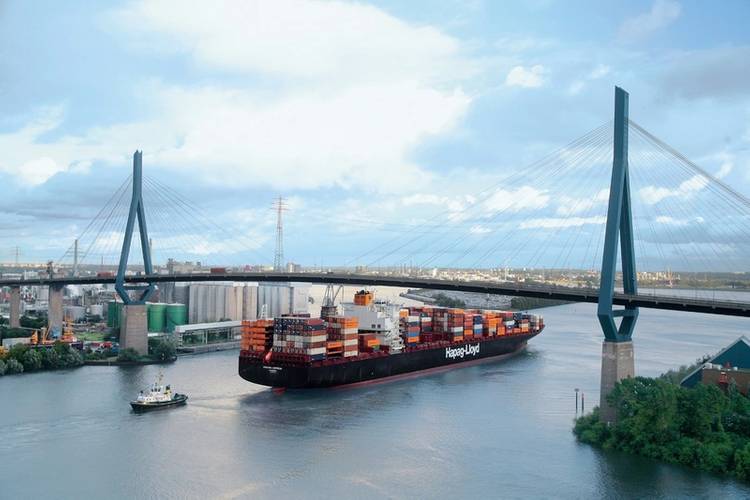Hapag-Lloyd Boosts Results, Volume in 2013
Operating result improved by €41 million to €67.2 million / EBITDA increases by €54.6 million to €389.1 million / 4.6% more transport volume / persistently strong competition and high energy costs
Hapag-Lloyd improved its result and transport volume in the previous financial year despite persistently tough competition. EBITDA increased year-on-year by €54.6 million to €389.1 million. The operating result also saw a significant improvement, climbing by €41 million to €67.2 million, meaning that Hapag-Lloyd performed well in comparison to its competitors. Thanks to its global liner network with almost 100 services, Hapag-Lloyd was able to take full advantage of growth opportunities in a difficult market. Transport volume rose by a total of 4.6% to approx. 5.5 million TEU across all trades in 2013.
“Both factors, the improvement in results and the higher transport volume, are clear evidence of the strength of Hapag-Lloyd in the global market,” said Michael Behrendt, Chairman of the Executive Board of Hapag-Lloyd. However, the average freight rate continued to disappoint, remaining $99 per TEU below the previous year’s level at $1,482 per TEU. Revenue declined to €6.57 billion (previous year: €6.84 billion), which was, however, due largely to a weaker US dollar, the main currency in the shipping sector. The Group posted a net result of -€97.4 million after -€128.3 million in the previous year.
“Although Hapag-Lloyd continued to perform well compared to other industry players thanks to the positive operating result, this result nevertheless falls well short of our expectations for 2013 and is ultimately disappointing,” Behrendt said. “However, as one of many market players, we are unable to avoid the general trend in rates, which was again characterized by irrationality in the previous year.” As a result, it was no longer possible to push through sustainable rate increases in the market from the second quarter, despite good ship utilization at times. The important peak season in the third quarter failed to occur again as in the previous year.
The earnings situation was positively influenced by additional cost-cutting measures, which Hapag-Lloyd introduced as a direct response to the development of freight rates in 2013, as well as a slightly lower bunker consumption price of $613/metric ton on average for the year. Overall, transport expenses were cut by €409 million compared with the previous year by means of savings and energy price effects. With a price level of around $600/metric ton, bunker still costs around three times as much as at the beginning of 2009.
Weaker-than-expected economic growth, particularly in the key BRIC states, had a negative impact on global transport volumes in the past year and thus on the course of business. Both the International Monetary Fund (IMF) and the World Bank had to revise their growth forecasts downwards in the course of the year. Furthermore, the protracted dispute surrounding the US government budget made the markets uneasy in the previous year. However, according to the IMF, the pace of economic growth is expected to pick up noticeably in many key markets during this year and next year compared with 2013. In particular, the USA, the world’s largest economy, is expected to return to its former strength with growth rates of 2.8% and 3% in 2014 and 2015. Following two years of recession, the euro zone is forecast to grow by 1% and 1.4%. Overall, the IMF expects global economic growth to accelerate to 3.7% in 2014 and 3.9% in 2015 after the 3% seen in the past year. The IMF anticipates global trade to expand by 4.5% and 5.2% in 2014 and 2015, with similar growth rates for global container traffic which is expected to grow by 4.4% in the current year and 5.2% in the following year according to forecasts by IHS Global Insight.
“The outlook is much better for the liner shipping sector, especially as the addition of new shipping capacities will decline and an increasing number of older ships will disappear from the market and be scrapped,” Behrendt explained. Hapag-Lloyd still has two newbuildings in its order book, each with a capacity of 13,200 TEU. Both will enter service in April this year and be used in the Far East trade within the G6 Alliance. “These modern and highly efficient ships are important for the competitiveness of Hapag-Lloyd.”
As a result of the financing measures carried out in 2013, Hapag-Lloyd said it is financially well positioned, making it possible to invest €743 million in the company last year (previous year: €791 million), notably in ships and containers to boost maritime assets. Among other things, Hapag-Lloyd successfully placed a corporate bond in the capital market with a total volume of €400 million in September and October 2013. The bond was oversubscribed, which underscores the confidence of the capital market in Hapag-Lloyd. The company has a sound balance sheet with an equity ratio of 41.9%. With liquidity reserves of approx. €534 million (including unused credit lines as at December 31), the company is securely financed for the future.
As part of the negotiations for Hapag-Lloyd to take over the container activities of CSAV, due diligence is currently being performed and other necessary talks are being held with various stakeholders to prepare for a possible transaction. A non-binding memorandum of understanding was signed by the two shipping lines on January 22.
hapag-lloyd.com














